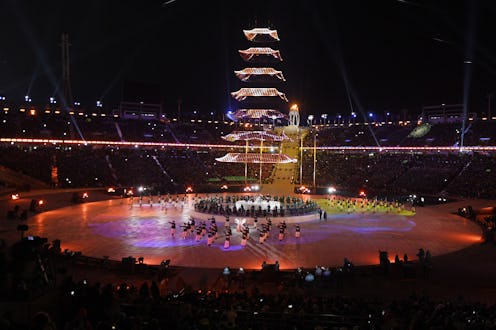News
This Is The Frigid Temperature Closing Ceremony Attendees Had To Endure

The 2018 Winter Olympics in PyeongChang held a lot of extreme weather, from frigid temperatures to high winds that interfered with events. For audience members, the opening and closing ceremonies were particularly brutal because they had to sit in a largely unheated stadium that was exposed to the open air. Both ceremonies took place at 8 p.m. local time in South Korea, far past the peak of the day's heat. After Olympic officials warned guests to prepare for extreme temperatures on Sunday night, many people around the world wondered just how cold it would be at the closing ceremony.
At the time of this writing, it was 34 degrees Fahrenheit, or 1 degree Celsius, in PyeongChang, which is about the same temperature as it was at the opening ceremony on Feb. 9. A slight wind made it feel a few degrees colder (the opening event was windier). In advance of the ceremony, it was predicted that the temperature would eventually drop below freezing.
While the stadium itself was unheated, it was likely outfitted in the same manner as the opening ceremony, meaning that 40 portable heaters were scattered throughout the arena with an additional 18 "heating respite" areas. Spectators during the opening ceremony were also given blankets, heating pads, and knit hats as part of what Channel News Asia called a "survival kit." The Olympic organizing committee more delicately called them "items to combat the cold and allow [... audience members] to enjoy the celebration in comfort."
Presumably South Korea decided not to build a more expansive heating system in order to save money on construction costs. The closing ceremony marked the final time that PyeongChang's 35,000-seat stadium will be used; the structure was built for the Olympics and will be torn down following the games. The county of PyeongChang has a small population and won't have much use for the stadium after the games.
To fight the closing ceremony's chill, members of the U.S. delegation wore insulated outfits provided by Ralph Lauren: big white bomber jackets, sweaters with red, white, and blue stripes, knit hats, and bandanas inscribed with the American flag. The look was supposed to have a vintage feel. Most importantly, the many layers helped keep the athletes warm. The Olympians were already better off than the audience because they were mobile: They were able to walk around the stadium during the parade while the thousands of spectators watched, sitting still.
The parka jackets that Ralph Lauren designed for the opening ceremony were even more insulated from the cold: They actually contained battery-powered heating devices. The company produced more than 700 of these to outfit every Olympic and Paralympic athlete.
While some complained about the cold temperatures during the closing ceremony, others were grateful that it was not as bad as the opening event had been. The Los Angeles Times acknowledged that "it's cold" but noted that it felt "considerably warmer than the frigid weather at the opening ceremony."
Despite the low temperatures, Tonga's flag bearer Pita Taufatofua appeared shirtless during the ceremony as he has done several times before. He made headlines for oiling up and walking shirtless during the opening event of the summer 2016 games in Rio, but his decision to do so in both of PyeongChang's freezing ceremonies is even more remarkable.
Of course, Taufatofua only disrobed for part of the ceremony. For his first appearance he wore a colorful outfit and flowers, saying, "I've got to stay warm, get the flowers out, let people see the color of Polynesia."
As is the risk with outdoor events that depend on snow, the Olympics suffered through some nasty weather this year. Certain competitions needed to be delayed: Strong winds of 50 miles per hour disrupted the alpine skiing schedule, for example, and even caused the South Korean government to send out emergency alerts about the risk of fire and flying detritus.